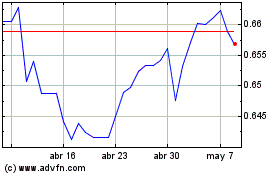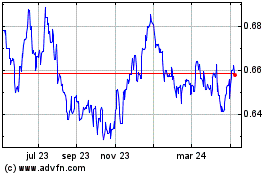Australian Dollar Falls After Weak Economic Data
01 Marzo 2023 - 7:11PM
RTTF2
The Australian dollar slipped against other major currencies in
the Asian session on Thursday, after the official data showed that
building approvals tumbled in January, adding concerns about the
strength of the economy. Data from the Australian Bureau of
Statistics showed that the total number of buildings approved in
Australia was down a seasonally adjusted 27.6 percent on month in
January, coming in at 12,065. That was well shy of expectations for
a drop of 8.0 percent following the downwardly revised 15.3 percent
spike in December.
On a yearly basis, permits for overall buildings dropped 8.4
percent, while permits for houses sank 12.0 percent and permits for
other than houses declined 0.3 percent. The seasonally adjusted
estimate for the value of total building approved fell 18.6 percent
in January, following a 1.0 percent rise in December.
The Australian dollar fell to 0.67280 against the U.S. dollar
from an early high of 0.67660. If the aussie extends its downtrend,
it is likely to find support around 0.66 against the greenback.
The aussie dropped to 91.78 against the yen from an early high
of 92.09. The aussie is likely to find its support around the 90.06
area.
Data from the Bank of Japan showed that the monetary base in
Japan was down 1.6 percent on year in February, coming in at
646.440 trillion yen. That beat forecasts for a drop of 3.2 percent
following the 3.8 percent decline in January. The adjusted monetary
base was up 31.1 percent on year to 657.838 trillion yen, slowing
from 43.8 percent in January.
Against the euro and the Canadian dollar, the aussie dropped to
1.5825 and 0.9167, from early highs of 1.5763 and 0.9190,
respectively. The next possible support for the aussie is seen
around 1.59 against the euro and 0.90 against the loonie.
Looking ahead, the Eurozone is slated to release its flash
inflation data for February and the unemployment reports for
January at 5:00 am ET.
At 7:30 am ET, ECB's monetary policy meeting accounts is set to
be published.
U.S. weekly jobless claims is slated for release at 8:30 am ET.
The data is likely to provide additional clues about tightness in
the labor market.
AUD vs US Dollar (FX:AUDUSD)
Gráfica de Divisa
De Mar 2024 a Abr 2024

AUD vs US Dollar (FX:AUDUSD)
Gráfica de Divisa
De Abr 2023 a Abr 2024
